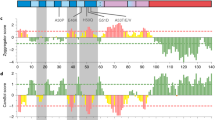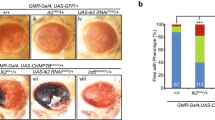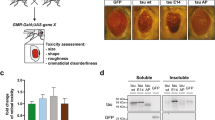Abstract
The transmembrane glycoprotein Nicastrin was identified in a complex with the multipass membrane protein Presenilin1. Presenilin mediates transmembrane cleavage of single-pass transmembrane proteins with short extracellular domains2, including the ligand-activated form of the receptor Notch3,4,5 and β-amyloid precursor protein (β-APP)6,7. Transmembrane cleavage of Notch is essential for signal transduction3,4,5, and transmembrane cleavage of β-APP generates pathogenic amyloid peptides implicated in Alzheimer's disease8. Here, we investigate the requirement for Nicastrin in Presenilin-mediated transmembrane cleavage. We show that, in Drosophila, loss of Nicastrin activity blocks the accumulation of Presenilin associated with the apical plasma membrane, abolishes Presenilin-dependent cleavage of the transmembrane domains of Notch and β-APP, and abrogates Notch signal transduction.
This is a preview of subscription content, access via your institution
Access options
Subscribe to this journal
Receive 12 print issues and online access
$209.00 per year
only $17.42 per issue
Buy this article
- Purchase on Springer Link
- Instant access to full article PDF
Prices may be subject to local taxes which are calculated during checkout




Similar content being viewed by others
References
Yu, G. et al. Nature 407, 48–54 (2000).
Struhl, G. & Adachi, A. Mol. Cell 6, 625–636 (2000).
Struhl, G. & Greenwald, I. Nature 398, 522–525 (1999).
De Strooper, B. et al. Nature 398, 518–522 (1999).
Song, W. et al. Proc. Natl Acad. Sci. USA 96, 6959–6963 (1999).
De Strooper, B. et al. Nature 391, 387–390 (1998).
Wolfe, M. S. et al. Nature 398, 513–517 (1999).
Esler, W. P. & Wolfe, M. S. Science 293, 1449–1454 (2001).
Goutte, C., Hepler, W., Mickey, K. M. & Priess, J. R. Development 127, 2481–2492 (2000).
Chen, F. et al. Nature Cell Biol. 3, 751–754 (2001).
Artavanis-Tsakonas, S., Rand, M. D. & Lake, R. J. Science 284, 770–776 (1999).
Greenwald, I. Genes Dev. 12, 1751–1762 (1998).
Brou, C. et al. Mol. Cell 5, 207–216 (2000).
Mumm, J. S. et al. Mol. Cell 5, 197–206 (2000).
Lieber, T., Kidd, S., Alcamo, E., Corbin, V. & Young, M. W. Genes Dev. 7, 1949–1965 (1993).
Kopan, R., Nye, J. S. & Weintraub, H. Development 120, 2385–2396 (1994).
Struhl, G., Fitzgerald, K. & Greenwald, I. Cell 74, 331–345 (1993).
Rebay, I., Fehon, R. G. & Artavanis-Tsakonas, S. Cell 74, 319–329 (1993).
Struhl, G. & Greenwald, I. Proc. Natl Acad. Sci. USA 98, 229–234 (2001).
Struhl, G. & Adachi, A. Cell 93, 649–660 (1998).
Nowotny, P. et al. Mol. Cell. Neurosci. 15, 88–98 (2000).
Guo, Y., Livne-Bar, I., Zhou, L. & Boulianne, G. L. J. Neurosci. 19, 8435–8442 (1999).
Ye, Y. & Fortini, M. E. Mech. Dev. 79, 199–211 (1998).
Fagan, R., Swindells, M., Overington, J. & Weir, M. Trends Biochem. Sci. 26, 213–214 (2001).
Schroeter, E. H., Kisslinger, J. A. & Kopan, R. Nature 393, 382–386 (1998).
Kidd, S., Lieber, T. & Young, M. W. Genes Dev. 12, 3728–3740 (1998).
Lecourtois, M. & Schweisguth, F. Curr. Biol. 8, 771–774 (1998).
Chou, T. B. & Perrimon, N. Genetics 131, 643–653 (1992).
Lee, T. & Luo, L. Neuron 22, 451–461 (1999).
Nolo, R., Abbott, L. A. & Bellen, H. J. Cell 102, 349–362 (2000).
Irvine, K. D. Curr. Opin. Genet. Dev. 9, 434–441 (1999).
Golic, K. G. & Lindquist, S. Cell 59, 499–509 (1988).
Brand, A. H. & Perrimon, N. Development 118, 401–415 (1993).
Acknowledgements
The nctR46 allele was isolated, mapped and characterized as a neurogenic mutation by J. Jiang in a prior genetic screen; we gratefully acknowledge his contribution to the present work. We also thank A. Adachi for generating transgenic lines, T. Lee, L. Luo, P.M. Macdonald, H. Bellen and Developmental Studies Hybridoma Bank for providing fly stocks and antisera, I. Greenwald for discussion, and I. Greenwald, L. Johnston, R. Mann, and members of the Struhl lab for advice on the manuscript. H.-M. Chung is a research associate and G. Struhl an investigator of the Howard Hughes Medical Institute.
Author information
Authors and Affiliations
Corresponding author
Rights and permissions
About this article
Cite this article
Chung, HM., Struhl, G. Nicastrin is required for Presenilin-mediated transmembrane cleavage in Drosophila. Nat Cell Biol 3, 1129–1132 (2001). https://doi.org/10.1038/ncb1201-1129
Received:
Revised:
Accepted:
Published:
Issue Date:
DOI: https://doi.org/10.1038/ncb1201-1129
This article is cited by
-
Neural functions of bisecting GlcNAc
Glycoconjugate Journal (2018)
-
CSF Presenilin-1 complexes are increased in Alzheimer’s disease
Acta Neuropathologica Communications (2013)
-
The Role of Presenilin and its Interacting Proteins in the Biogenesis of Alzheimer’s Beta Amyloid
Neurochemical Research (2007)
-
The players on the γ-secretase team
Nature Medicine (2006)
-
lin-12 Notch functions in the adult nervous system of C. elegans
BMC Neuroscience (2005)



